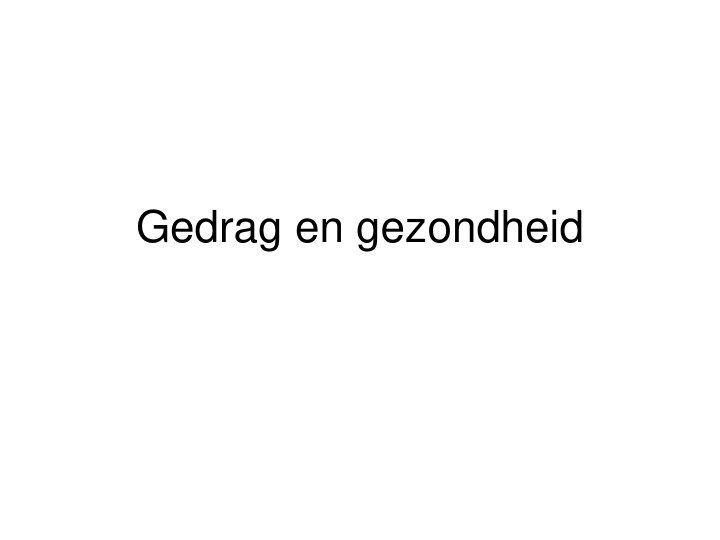



Gedrag en gezondheid
Schroeder, S.A.
Effect of healthy lifestyle Willett (2002). Science, 296, p696.
Reduction of hospital utilization in patients with chronic obstructive pulmonary disease: a disease-specific self-management intervention. Bourbeau et al. BACKGROUND : Self-management interventions improve various outcomes for many chronic diseases. The definite place of self-management in the care of chronic obstructive pulmonary disease (COPD) has not been established. We evaluated the effect of a continuum of self-management, specific to COPD, on the use of hospital services and health status among patients with moderate to severe disease. METHODS : A multicenter, randomized clinical trial was carried out in 7 hospitals from February 1998 to July 1999. All patients had advanced COPD with at least 1 hospitalization for exacerbation in the previous year. Patients were assigned to a self-management program or to usual care. The intervention consisted of a comprehensive patient education program administered through weekly visits by trained health professionals over a 2-month period with monthly telephone follow-up. Over 12 months, data were collected regarding the primary outcome and number of hospitalizations; secondary outcomes included emergency visits and patient health status. RESULTS : Hospital admissions for exacerbation of COPD were reduced by 39.8% in the intervention group compared with the usual care group (P =.01), and admissions for other health problems were reduced by 57.1% (P =.01). Emergency department visits were reduced by 41.0% (P =.02) and unscheduled physician visits by 58.9% (P =.003). Greater improvements in the impact subscale and total quality-of-life scores were observed in the intervention group at 4 months, although some of the benefits were maintained only for the impact score at 12 months. CONCLUSIONS : A continuum of self-management for COPD patients provided by a trained health professional can significantly reduce the utilization of health care services and improve health status. This approach of care can be implemented within normal practice. Arch Intern Med. 2003 Mar 10;163(5):585-91
Prediction of low back pain chronicity Physical (21%) Fear-avoidance (25%) Fear-avoidance (23%) Psycho-social (37%) 6 months 7 days 4 weeks 7weeks 12 weeks 2 months 12 months (Klenerman et al. 1995)
Gedragsverandering • Common sense
Volgzaamheidsmodel (assumptie ‘beter weten => anders doen’) • Communicaties • Belangrijkste argumenten Levendig en kleurrijk Primacy effect Kort, helder, direct Recency effect Geen/weinig jargon • Framing Geen/weinig statistieken Winstframing voor protectief gedrag Case histories Verliesframing voor gedrag met onzekere Aangepast aan de culturele normen uitkomsten en/of detectie van ziekte • Communicatiebron • Conclusie Expert - prestigieus Vertrouwensvol Expliciete actievoorschriften “Likable” • Vragen van extreme of • Ontvanger onaanvaardbare verandering Pro: belicht alleen pro’s Leidt tot afwijzing van de boodschap Contra: belicht pro en contra
Schrikinductie • heeft effect • werkt slechts kortdurend zonder herhaling • modererende rol van “response efficacy” • herhaling leidt tot habituatie • extreme schrikinductie leidt – soms tot ongewenste angst (health anxiety) – soms tot afkeer van de boodschap • netto effecten zijn niet beter dan “positive appeals” advies : positieve boodschappen te verkiezen boven schrikinductie
Self-efficacy
Gedragsverandering • Advanced knowledge
Taxatie veranderbaarheid van gedrag via individueel probleembewustzijn • Kans op individuele gedragsverandering afhankelijk van 1) gevoelde ernst (severity) 2) subjectieve probabiliteit (susceptibility) 3) subjectieve inspanning/voordeel (cost/benefit) 4) ervaren temporele relatie • redenen voor de stabiliteit van gezondheidsgedrag 1) aangeleerd in krachtige leeromgeving 2) “onrealistisch optimisme” 3) “habit”-status van gedrag 4) vaak verslavingscomponent aanwezig
Harrison, et al., 1992, HER, 7 (1), 107-116
Theory of Planned Behavior (ASE-Model - Kok) Attitude Barrières Sociale Gedrags- invloed intentie Gedrag Eigen Vaardigheden effectiviteit
Gedragsverandering is een proces geen eenmalige beslissing
Sociaal-ecologisch modellen
Gedragsanalyse Determinanten?
Analyse van gedragsdeterminanten Een voorbeeld
Specific Measurable Goal setting: Attainable SMART Realistic Timely
Nudges vs. shoves vs. smacks Een zetje Een duw Een klap
Nudging: voorbeelden
Nudging: Efficacy
Recommend
More recommend